Proportions and high/low: Lessons from womenswear
The world of women’s fashion is huge. In variety, scope and scale, it towers above menswear. Yet, usually, men keep women’s styling at arm’s length, because it seems so different to what we know, and because it isn’t made for us.
However it’s not uncommon for women and women’s designers to pick up cues from what menswear and adapt them. So I’ve been thinking about the opposite: what can a man learn from women and their approach to clothing?
There are many things of course, from individual pieces to interesting colour combinations, but one that strikes me is the inherent innovation and creativity of womenswear. Women’s clothing often seems more expressive and playful, which is something I’m interested in exploring to break up the serious sobriety of men’s fashion.
The tricky question I’ve run into is, what can be taken from that side of fashion without being over the top? What can be expressive but also practical and honest?
Consider the designer Molly Goddard, for example. She makes dresses that I think are stunning to look at, in terms of quality, make and shape (above). But I’m not going to wear one any time soon, and her menswear range is less interesting. Therefore, what can I take from it?
A large part of the appeal of her designs is an understanding of proportion, and how this can, in a garment, take up space. Physically and fundamentally it creates stature.
As someone who prefers wider or more relaxed silhouettes, this idea of making creating space through proportion really speaks to me, and this thought process has led me to be inspired by women I’ve seen who take this further without necessarily resorting to extravagance. Think a very large coat with the sleeves rolled up, an untucked cotton poplin shirt cut oversized or bought 2-3 sizes too big, and wider-than-wide trousers.
Melissa Jane Tarling (above), a stylist and art director, is someone whose personal style is all about playing with or utilising the effects of proportion.
She favours voluminous tailoring – loose jackets and trousers or skirts, blouse-like shirts with long sleeves, large overcoats in varying earth tones. They often recall those eighties Ralph Lauren or Armani ads, though whether consciously or not I’m not sure.
You’d think all this flowey clothing would just create a mess of fabrics, but there is in fact cohesion – everything flows together ,even when it’s a mix of makers and brands. There are elements of fashion (Nanushka or Ferragamo) but the overall look is more traditional, reminiscent of 20th century artists or Mediterranean rural lifestyles. There’s a classical elegance yet it still feels modern.
So, how do I begin to dissect such a strong look and find what a man can take from it?
The first thing is playing around with layering, and paying attention to how materials move in different shapes and sizes. Linens and wools, sweaters in a relaxed cut and unstructured double-breasted jackets. Larger scarves that aren’t just oversized but stoles, which makers such as Begg x Co do in attractive neutral hues.
It’s arguably not far off the look Adret is known for (below), but whereas that has its roots in a specific style and a texture of garment, Melissa’s feels and looks cleaner and contemporary. It’s more personal because it’s been built up with a variety of brands.
Nowadays we go to great lengths to subvert tailoring, to contrast it with more casual clothing in order to make it more relaxed. Yet this is a second area where women have been doing far better for far longer, in my opinion.
Take Ralph Lauren famously donning a pair of faded jeans with black tie. Yes, it is a valid example, but it’s really a look few can co-opt without looking like they’re trying to emulate the man himself. Whereas the inherent freedom of womenswear, with its huge variety of styles, makes it easier to mix things up, to freshen what we consider classic pieces and make them more interesting, or simply relax and subvert expectations.
I saw a perfect example over the summer while sitting having coffee. Two women in their sixties were wearing voluminous Molly Goddard dresses - one white and one pink - but worn over the top, to stave off the chill of air conditioning, were MA-1 bomber jackets from Alpha Industries.
My biggest regret is I didn’t take a picture, because it encapsulated not only high/low dressing but also that balance of masculine and feminine. The contrast made it interesting: the unexpected with the conventional, the delicate with the durable.
This kind of statement dressing is not something most men will want to adopt, but there are always examples in womenswear – like the woman below mixing heels, a flowing skirt and bright nylon gilet. Simple, but punchy.
This inspiration has encouraged me to take greater risks, looking for combinations where such high contrast is possible without looking ridiculous.
It’s also often, I think, about adding a layer of comfort to otherwise sharp and perhaps restrictive clothing. It’s vintage 501s with silk shirts; it’s leaving the overcoat at home and throwing on a well-worn chore coat over that otherwise immaculate dark suit and roll neck on your way to dinner; or it’s choosing to wear highly divisive jazz shoes with tailoring, simply because they’re more comfortable. It’s something that men such as Gauthier Borsarello (below) do very well.
When looked at in these ways, you can start to see that women’s fashion needn’t be kept that far away from men’s. Again, this is not to advocate simply co-opting womenswear (unless that’s your own particular style or desire, in which case more power to you).
Rather, these are just a few thoughts and examples that I have found inspiring, after months of the subject rattling around in my head. It’ll be interesting to see what more comes up, for me and perhaps for readers too. The wonderful thing about women’s fashion is, there’s so much to choose from. The world of womenswear is huge.


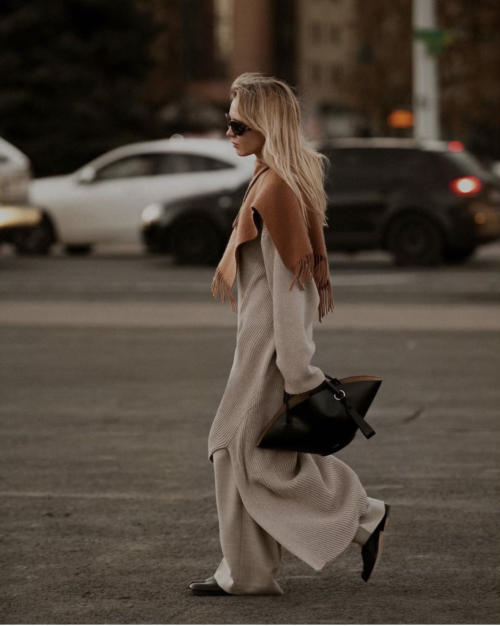
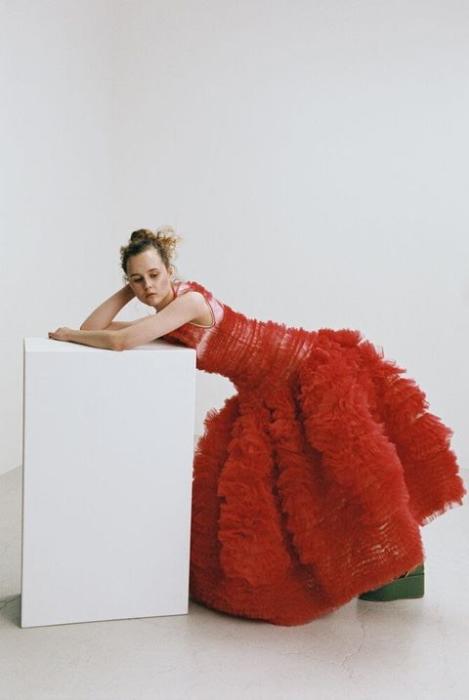
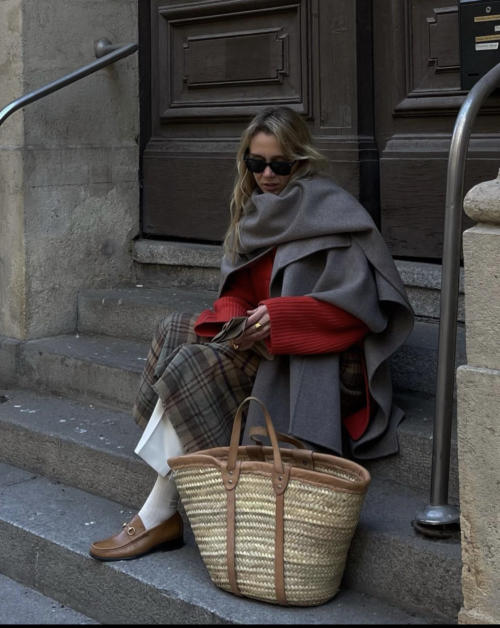
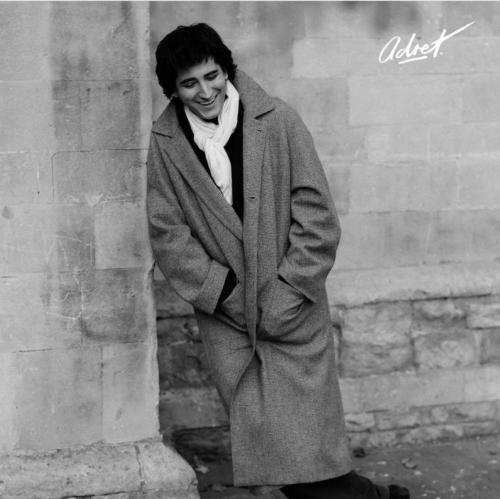
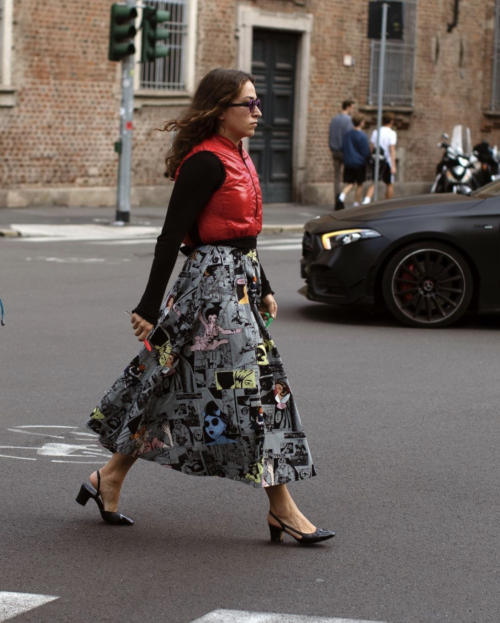
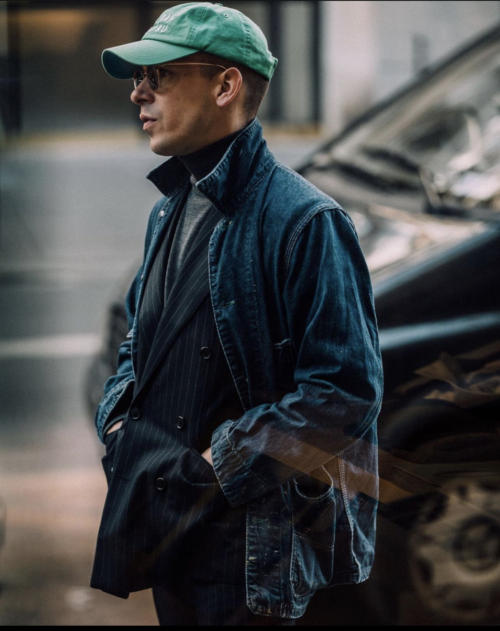


























Brilliant article and quite timely as it’s something I think about a lot and put into practice quite regularly. In retrospect it comes from having two very chic grandmothers and an equally elegant mother. They always looked incredibly interesting and elegant and it’s from them that I take a lot of style cues, perhaps surprisingly more so than my dapper Grandfather and Father. Thanks for this Andre, great read.
I have been wondering about this relationship between women’s cloths and men’s . For example the oversized coat look this winter in Europe, which seems to work for both men and women, especially with an appropriate scarf. I buy quite a lot from opp / thrift shops. This means that many items are only roughly to size but when the fabric is a good weight and color, with the proportions correct, it seems to work. I will often roll sport coat sleeves (if a bit long) to the first button, to show the shirt cuff and this in itself gives a relaxed vibe with chinos or dark jeans. Women often do this with slightly oversized garments. With women it’s not only about the cloths they wear, but the confidence and enjoyment of wearing them. Effortless. Many things make it work ,I think subdued neutral color, quality fabric, proportion and appropriate shoes. Something men could learn from. Easy to say. More difficult to achieve. But there is a lot to learn from the way women put together an outfit that works on a number of levels.
Thanks Paul, nice points
Some excellent points Paul, particularly about how women enjoy wearing their clothing and often do so in an effortless manner. Men could certainly learn from women in this area. Men can, and should, still dress in a masculine manner without looking effeminate or like a peacock, but enjoy their clothing.
Men “should” dress in any manner they like, effeminate and otherwise .
This is definitely my favourite of your articles so far, André. Some food for thought.
I do find that it is much harder to pull off the high-low dressing with classic menswear. The above example, with a (denim?) jacket and baseball cap over a pinstripe suit doesn’t look very good to me. It looks like exactly the kind of thing a #menswear guy would post on his #menswear instagram to show how he likes to #suberttailoring. I think the trick to successful high-low dressing is that it has to look natural, like the kind of thing someone might conceivably “just throw on”. I think the picture of Melissa shows that done better; it seems like she could have just thrown on layer after layer of comfortable clothes, until she felt warm enough. I have no doubt it’s an engineered look, but it doesn’t feel like it is. I think the loose, flowy silhouette helps a lot?
Of course, I am probably biased because I “know” that a double breasted pinstripe jacket is “formal officewear” and I know enough people who try (with various degrees of success) to “subvert tailoring” that I have a mental image of how it looks. I know less about womenswear, so I might not make the same mental jumps – still, I think if Melissa had layed oversized clothes over a base of 80s power dressing, I would be more inclined to think of that as looking forced too.
It might also be possible that womens style is easier to combine in high-low combinations because it has a more fluid definition of formality. Classic menswear has a rather strict hierarchy of formality, where as I experience womens fashion to be more flexible there. In my experience, high-low looks best when the individual pieces don’t stray TOO far from each other – silk shirt and jeans as you suggest (perhaps worn with cordovan penny loafers), would likely work. Poplin shirt, jeans and oxfords would be much harder to pull off.
Anyway, great article and some really well chosen pictures to illustrate it, even if I don’t agree on everything 🙂
I think there are some really good and interesting points there, especially about the modes of formality creating subversion in high/low dressing for men, rather than a more fluid harmony in womenswear.I’m definitely someone who aspires to subvert more formal clothing, probably more so I can pull off items of clothing that I love in a generally more casualized environment. Think tailored jacket at a london pub. The playing around with subversion is something I’ve enjoyed, but often found myself wondering why things look a little affected. I think you’ve hit the nail on the head totally. Really, I aspire to dress like the photo of Melissa Tarling there but probably end up looking more like the guy in the chore shrouded suit. I don’t think there is a male equivalent.
In a moment of inspiration after having read this article, I went and pulled a Begg & co stole scarf out of my draw, and threw it nonchalantly over the shoulders of my herringbone tweed jacket, which I am wearing over a large, billowy but tucked in t-shirt. The colours worked wonderfully, but I still laughed at my reflection. It looked mental. Like I suddenly decided I didn’t look enough like braveheart.
In a culture in which there are exceptionally few benefits to being female, having a far more fluid and expressive mode of dress is certainly one I envy! I wouldn’t want to wear quite what she is wearing – I don’t want to cross-dress – but I certainly want to emulate it’s spirit. I don’t think we can completely. Personally, the Adret style of men in billowy, shawl like clothing never fully works for me. It doesn’t look nonchalant and natural, like you suggest, but rather like a very engineered ‘look.’
Would that ever happen with one look you just try on the spur of the moment though? More unusual modes of dress often take some playing around, as André has clearly done, and different things work for different people too. That doesn’t mean there’s nothing between the two
True. I suppose my ‘method’ – putting a scarf on and deciding the entire thesis was nonsense – wasn’t exactly empirical. Still, I was being somewhat playful about that!
I was agreeing with the broader point Sams was making though. That there are restrictive norms in menswear, which womenswear seems less beholden to.
Yes, very true.
I just don’t want people to be put off having a play!
Particularly when finding something you like (for men and women) always takes some experimenting (and mistakes)
I think it might help to look at what pieces women who manage to pull off those looks actually use. Melissa doesn’t wear any tailoring in her look, it all looks heavy but soft. Flowy. Possibly floppy. I find the PS donegal coat is a great piece to work with for some slightly oversized looks (though at 6’4, very few things are oversized to me). I could see that, some chunky knitwear, and full cut trousers work with an oversized scarf the way I doubt a tailored jacket would. Still runs the risk of looking a bit cosplay-y, but at least they will never take your freedom!
Associations also factor in. I’ve seen a couple of younger women who could look contemporary, even rebellious, in tweed jackets in a style that would make me look like I’m getting ready to deliver a lecture on Anthropology 101. Some things are easier to pull off if you look young and hip. On the other hand, as a silver-haired man I can wear a pin striped, double breasted flannel suit without looking like it’s aspirational. Whether we like it or not, the “whole look” factor in, and that includes the wearer.
Excellent points! Though also being 6’4, and quite broad, I am in the same camp. Clothes that would make some people look quite louche, in a thrown on effortlessly kind of way, tend usually to make me look smart and put together, on account of how much I usually fill up an item of clothing. On the other side of the coin, when I do try on oversized clothing, I think I look a bit like Hagrid. It creates such a monolithic block of colour, especially in overcoats, that I wonder if oversized clothing isn’t entirely suitable for people of our height!
You’re right – dressing with rather than against the grain of your body type and overall look is important.
Now that I think of it, I think most men who pull off the over sized look tend to be quite short, with a slender build. I’m thinking that it may look more natural for someone smaller, and probably younger, to wear the oversized look, like they borrowed the clothes from someone else, or had it handed down from an older relative.
I guess taller men can look a bit lumbering (or lanky, if we’re on the thinner side), and oversized clothing can exaggerate that impression.
Being 6.4 myself and heavy set, I think you’re definitely on to something. When you’re a bigger guy and wear a bit of oversize, there’s a big chance it’ll just look like we’re just wearing baggy clothes because we’re big.
I do realize I use the term “we” when I might be talking more about myself.
I for one do look a lot at womenswear for inspiration too, especially on cut and proportion. I do agree you have to be quite slender to make a look like this work, man or woman.
What I try to do on my end is take advantage of the fact I’m tall and heavy set. I generally need a leg opening of 24 cm for a clean straight cut, so I’ll play with 25-25.5 for effect. I don’t really want to play around with jackets too much, they’re already fuller and longer than most. I find the same true with knitwear, personally. Oversized knitwear on me will just look sloppy.
A below the knee coat looks great on me, but mid to lower calf works too, without looking over the top, as it might do on somebody shorter, so that’s another thing I’ll take advantage of.
For summer, playing around with roomier shirts worn untucked together with equally roomy and lofty linen trousers has also been a nice change of pace. So I guess I play more with volume and cuts in a bit of harmony rather than contrasting volumes and multiple layers, but it’s what works for me, according to me.
I’ve also always been sort of jealous at women because it’s feels a lot more natural for them to wear completely different styles on a daily basis than it does for us guys, without necessarily looking like fashion victims.
While not applicable across the board, I’d also like to mention the fact women in general use a lot more high street and fast fashion clothes. This gives them the benefit of incorporating a lot of textures via viscose shirts looking like silk etc without breaking the bank.
Do you mean it looks forced and engineered on you whilst you try on the clothes, or engineered by their ethos? At the end of the day, there is no real difference between all brands sharing threads that you either enjoy or do not. Simple as that. It is the wearer who will look engineered if he is not confident enough to carry an ensemble.
I have learnt so much watching my wife shop. Her grasp of colour matching seems instinctive and is never afraid of bold colours. Whilst I take an age fussing over the exact shade of socks, she acquired a polka dot blouse and bright blue trousers and just knew they would match. She never really mentioned the colours but was insistent that the shapes would match.
Still,I have a very nice pair of green socks.
I recently hired a young French woman as a consultant to help me finish curating my wardrobe to to also help strategize the best ways to style what remains.
Her emphasis is overwhelmingly on fit and silhouette. She showed me for example, two of my own mid-gray slacks (nearly identical in size and fabric but subtle differences in rise and drape) and how one was ideal in terms of silhouette and fit and the other, not so much. Little things make a big difference.
Color was not a big deal to her. Men tend to stick to more neutrals and so there’s less of a problem with colors that don’t match to one’s natural skin tone.
She also opined a lot of matching extremes – a loose shirt or jacket and slim-fit slacks. Or vice versa. Many of the same clothes, but remixed in very clever ways and a use of accents that I had never really considered before … classic menswear has had the same basic “rules” for decades.
You can break the rules and find a very interesting outcome. I wore a simple outfit she planned for me and got compliments with how smart I looked. Same clothes. Different mix.
I’m a fan.
The thing about oversized top and slim bottom (or vice-versa) is very commonly brought up in womenswear. Unfortunately, this concept of contrasting volumes probably works for knitted tank tops, skirts, blouses and bell bottoms or many other womenswear items, but I feel it is completely misguided to apply it to suits, as the opposite is true there generally.
Clearly, a very slim jacket is just uncomfortable so that’s not really an option to begin with.
Most people in Italy try to do the opposite, they wear tailored jackets with super slim trousers. But the effect is comical, the change in silhouette too abrupt, and it ultimately looks like the jacketed torso is walking on sticks.
And that’s before even mentioning the myriad of other problems with skinny trouser hems, such as OTC socks sticking to trousers, and trousers pooling on top of shoes instead of going around the very top of them. In fact we should not forget that in menswear cropped trousers are not acceptable business attire, so we can’t solve this specific problem of very slim trousers like they do.
True And, and with tailoring moderation and elegance are always the aims in particular. I do think it’s interesting playing around with it in more casual clothing, but again always with less extreme versions than you may see in womenswear
A big flowing coat,scarf and hat is a good start. I’ve taken a little PS influence and usually wear my top coat unbuttoned.
I quite like the idea of addind a less elegant chunky loafer to add a little more shape.
Oh chunky loafers…. I have spent too long lusting over the chunky Paraboot loafer that to me looks great but the ‘other’ me knows I will never wear them. What an absolute bugger.
Perhaps the young French woman stylist mentioned above would make a good interview for the site – another, perhaps quite different, perspective?
Very nice idea, thanks Aaron
All true. My comment was more of a general one than specific. But I do recall my tailor, when he was measuring me for shirts, asking (this was during my first visit), “Would you like a chest pocket with these?” and I replied, “No”.
“Interesting”, he said. “Because NONE of my customers ask for one. It breaks the line.”
I recently went through a Purge. I probably had over 200 items in my closet and now I’m down to 30 … all of which are completely interchangeable. Simple colors, clean lines, and all very high quality. I’m probably more creative today than before simply because i have to think about what I’m doing with color and texture.
I do enjoy the posts from Pitti Uomo. The best ones are the usually the ones that bend the rules. It reminds me of my days as a brand manager for a Fortune 50 company. The best adverts, by far, where the ones that bent the brand identity to the extreme, without breaking it.
Good fun. Still learning.
I agree that there is something to learn from women in regards to styling, it’s a well known fact that they are generally better dressed than men in most parts the world.
I think though that there is a fundamental difference in how women and men are perceived and what they can get away with when they put effort in styling. Or more precisely how they do it.
When we’re talking about high and low dressing, where the main goal is trying to make tailoring more wearable, I for example much prefer what Simon did with dupioni-silk jacket and black cords combination to what Mr. Borsarello is attempting to do in that particular photo.
These are interesting thoughts.
Possibly, just an educated guess and no data to back that up, a lot of the rigidity of classical menswear might come from, among others, the following factors: (i) Many men don’t seem to care much about fashion and are happy to wear something that won’t make them stand out. This somehow obligates the men, who are interested in fashion, to go along as they would otherwise stand out like peacocks. (ii) The roots of a lot of classical menswear seems to lie in military garments, never a good basis for diversity but rather uniformity. (iii) The inherent fear of many men to not look “manly” enough when experimenting, though that might be changing. (iv) A general laziness of many men to take the easiest road, at the most basic level jeans and t-shirt and jeans and shirts for work.
In my opinion this can really be summed up to say that the root of the problem really is that men have been taught all along that fashion is not manly, and that they should only care to dress *appropriately*, and that’s all there is to it.
As long as they don’t hold any interest in clothes, style, fashion or any other related concept, which again they mostly don’t because “not manly”, they will never move up from what’s merely “appropriate”, which is not even a judgement on aesthetics but merely based on observation.
Indeed, with the death of dress codes, men have broadly decided to define “appropriate” strictly by majority consensus: what most of their peer wear to any given occasion is what’s self-evidently appropriate for said occasion, regardless of how much it is (or isn’t) elegant, attractive, appealing, or any other connotation one might conjure.
So obviously this cannot bring anything but uniformity (and sadly, often towards the lowest common denominator too).
Interesting. There may be indeed a connection in between how a typical parisian woman would wear outfits much closer to the body than examples provided here and French tailoring for men which tends to be closer to the body as well.
Wonderful piece! I’m looking to more on this subject!
Nice article wich made me think of many stuff. Can you tell more about this adret coat ? It looks so nice. How much does it cost ? Is it rtw or bespoke ?
They only do RTW, but I don’t know the cost I’m afraid.
Great article! Reminds me of an interview with Nakamura-san from Beams, he talks about keeping an eye on trends in women’s fashion as they tend to be a few years ahead of men’s (more relaxed silhouettes being the example he mentioned)
This sounds like a good one – I’ll look out for it, that mans already on it!
“the serious sobriety of men’s fashion” is what interests the vast majority of that smallish minority of men who are interested in clothes in the first place…
🙂
Please leave these type of articles for WWD not ps
Thanks Yosef, but no I’ll continue to explore areas like this. I’ve written about women’s clothes and how inspiring they can be for quite a while (see here on Ralph for example)
Agreed with Yosef.
Hi Yosef,
I’m very glad that you think my writing is worthy of WWD. I’m movin’ up in the world!
Sorry, not a fan of the oversized, billowing look either on the female model or on men, in general
It looks good in pics. She’s a model & styled for the photoshoot.
But it’s simply too fussy & impractical in real life.
All that extra volume flapping around
As an example.
A robe coat (with belt) is loose & billowing.
If you’ve ever worn one you will probably find it tedious to keep on having to belt it up – otherwise it’s not practical & doesn’t look good unbelted.
You simply can’t wear it unbelted like you can with a SB or even DB coat
Plus if you’re skinny, udner 6ft, narrow-shouldered with a small head like Andre Larnyoh, it accentuates the ridiculous proportions even more.
It makes you look even skinnier.
The clothes are wearing you instead of the other way around.
I think a lot of that depends on the proportions (being smaller that is). Also, if you have a belted coat you tie it at the back if it’s open.
Melissa actually tends to dress like that in her day to day and those images weren’t for any particular brand.
In terms of what it accentuates, I’ve never found it to make me look like my clothes are wearing me or emphasising how slim I am – I’d get that more if I relied on slim fit clothes! Rather this just tends to hide it. I think it’s about understanding your own body proportions and then playing accordingly. I’ve never noticed myself to look skinnier in loose clothing because I’m aware that there is only so many sizes up I can take in a shirt or jumper.
I think there’s a key point here, André. There’s a fine line between loose fit and too big, just as there is with slim vs skinny/too right.
This particular form of “high/low dressing” pictured in the last photo (casual jacket thrown on top of a business suit) just screams “I don’t have a proper overcoat” to me. Just get on the metro in the morning and you can see a good amount of people with puff jackets on top of their suits, sometimes in very loud colours.
Yes, more people should wear proper overcoats, absolutely absolutely. But no, it’s worn for style and I think can work really well like that – and of course for weather in between
Yes, I see it’s done for style, I’m even quite sure that Mr. Borsarello has more overcoats than I do. I just can’t avoid the association with the “real life” version of it.
I see, yes understood
This is a very good article and resonates strongly with me. I grew up in a women’s world of style. My mother had been a seamstress for a well-respected clothier and always knew how to dress well, and my mother-in-law had been a window dresser whose sense of style she passed down to my wife and her 3 sisters. None of this had much effect on me growing up or into adulthood, except perhaps subliminally. But in my 40s I become very conscious that my wife and her sisters dressed impeccably almost all the time, and as I started to care about how I dressed I realized where the impetus originated.
We have a lot to learn from how women dress, although sadly I feel that the gap has narrowed. The slobbish and selfish approach (eg dressing like a child rather than an actual adult) seems to have infected the fairer sex almost as much as it has men.
Lovely point at the beginning there – so much of early style is learned from those around us, and it can be female as well as male
Happy new year to you Simon & your loved ones! My best wishes to all PS readers too!
At the beginning of this new year, there’s an old advice I would like to share with you all. And that’s this one: to look good – let alone to look elegant – don’t try too hard. It never works.
John
One thing overlooked in this article is, I think, one of the two most important things men can take from women – dressing for one’s figure. Perhaps it is difficult to convey in still photographs – but it is something which one very much appreciates when you see people in the flesh. To take Melissa as an example, a lot of the force of her way of dressing comes from the fact that it complements her figure/stature (she’s very slight). This adds real force to her style because it projects an image which is made up of the inter-relationship between what is organic to her (her physical body) and the ‘oversized’ clothes she wears – there’s a dialectical tension between the two which creates a dynamic sense of style. One of the risks of buying mens-wear is slotting into what other people are doing without reflecting on what suits your own figure. Women can teach you a lot about that.
As an extension of this (and the second and most important thing one can learn from women’s dressing) – perhaps because the scope of women’s clothing is so much broader than men’s and leaves so much more room for getting things both right and wrong – women underscore the importance of how you dress being an extension of yourself – not just physically, but philosophically/emotionally.
Hemingway said that only the tip of the iceberg showed in fiction – the reader only sees what is above the water – but the author’s knowledge about his character which never makes it into the story acts as the 7/8s of the iceberg which is below the surface and unseen. It is this which gives the 1/8 above the surface weight and gravity. That seems like a fairly good rule of thumb for clothing. Picking up the typical mannerisms and hobbies of internet men’s style (cigars, silly hats, vintage cars etc.) is not really going to cut it in that regard. I think this is the reason why the same garment can look like a costume on one person and entirely natural and appropriate on another. Or to take that even a step further, some people can get away with looking “costumey” whilst still having integrity of style, whilst others cannot because they lack the hinterland to justify the clothing.
Perhaps Simon we need an article on the unspoken relationship between hinterland and visual style and how the former lends force and integrity to the later?
A good idea, thanks NC, and great point on the relationship between physique and clothing.
This was only two points that can be taken from womenswear, of course, and great to have more added.
Damn JC, that’s food for thought there and that’s a great article idea.
That point about dressing for your figure is a point I’ve overlooked as well with this piece – it’s a tricky one to approach because the aim would be to cover what would work for different body types and what wouldn’t. However I feel that requires a deft touch. Which is where your mention of the relationship between hinterland and visual style comes in.
Brilliant article, Simon. Simple concept but I’ve never seen it done before. Probably because it’s a simple concept that few could articulate and carry through to a conclusion. Fascinating area to think about more for me
Women’s wear clothing is so much more fun! As a guy myself, I sometimes walk around in women’s only clothing shop to see what they are doing. The amount of texture in their clothing is so much more varied. We have got a lot to learn from women’s wear! Recently I bought a shaggy knit sweater in Japan that I love very much. Something Ill never find in Singapore where I am from (well it could be because Singapore’s climate is unsuitable for such clothing). Japan might also be one of those places where the gap is slightly smaller between men’s and women’s wear in my experiences so far.
Nice article. One nice change in menswear is the increase in variety of hues and colors options for black tie like the velvet jacket Daniel Craig wore here.
https://www.gq-magazine.co.uk/fashion/article/daniel-craig-pink-tuxedo
Some French brands like Lemaire seem to be taking some risks with silhouettes and shapes. Husbands too, but in a more conservative approach. Alexander McQueen has some rather out there suits for me, but they remind me of the ways women take risks in attire.